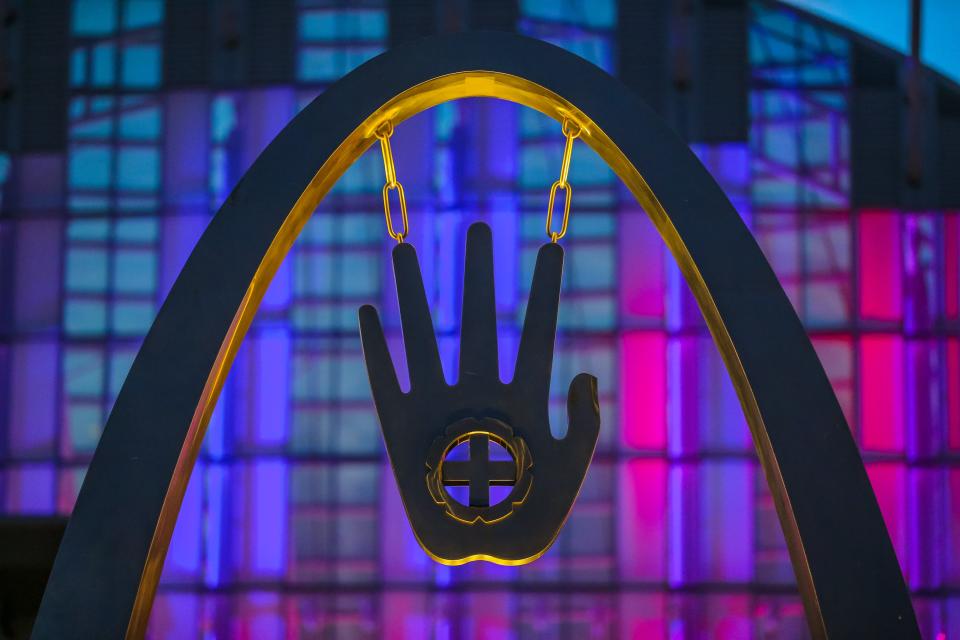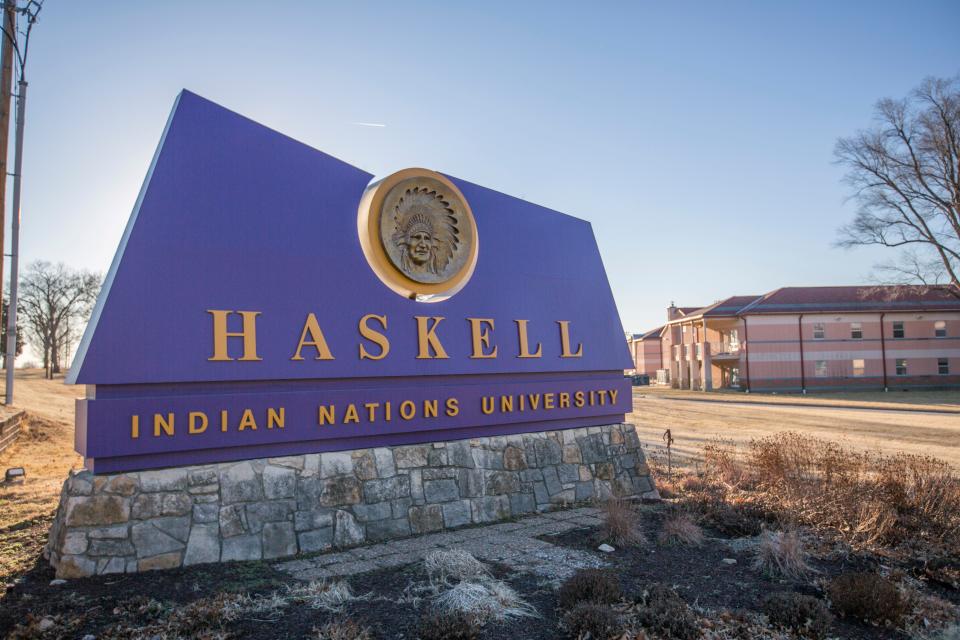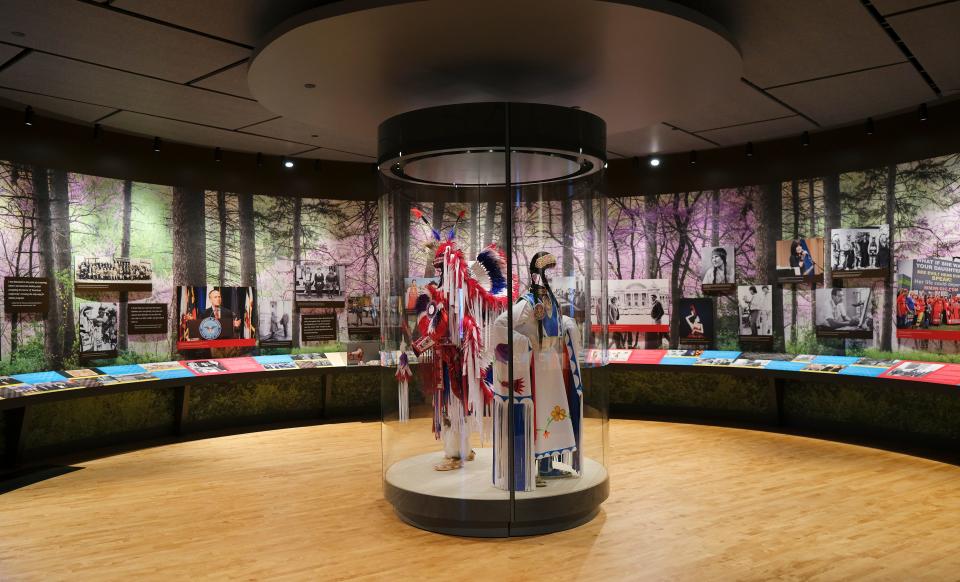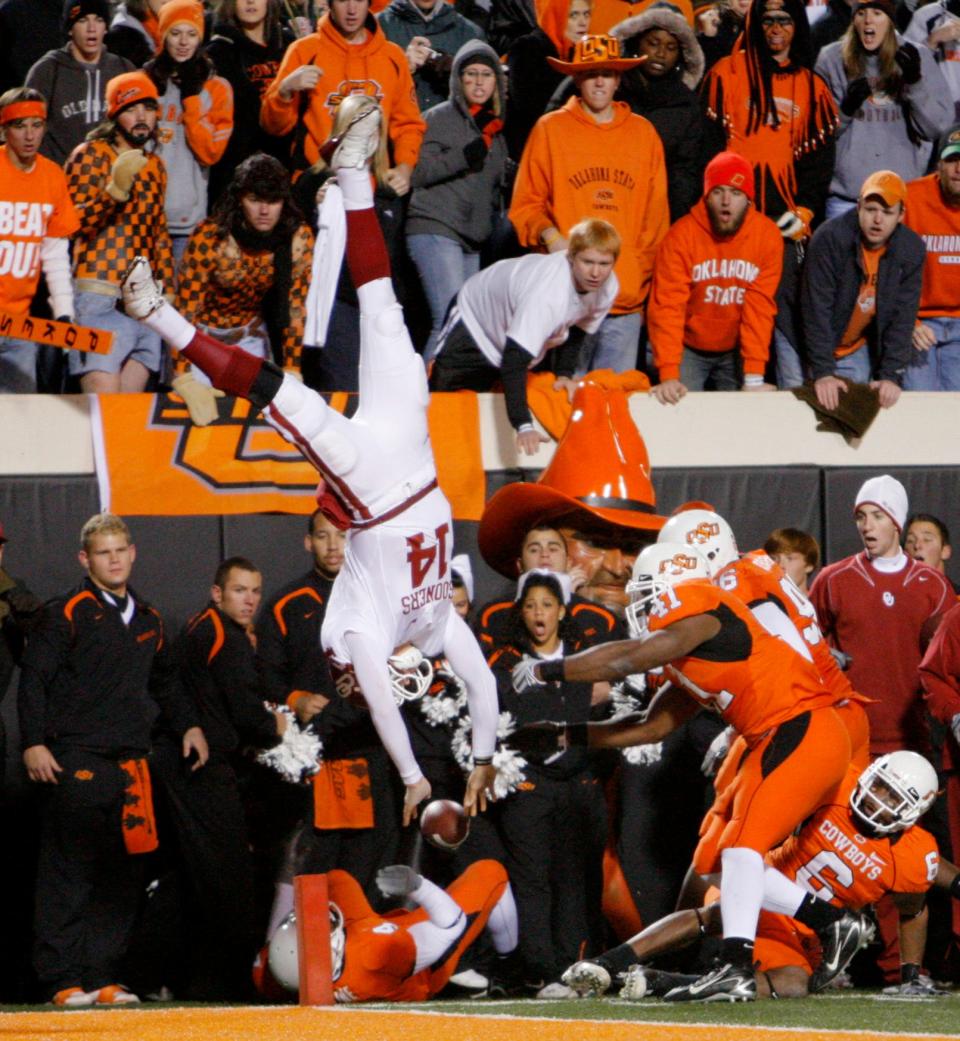A Native American hall of fame teetered on collapse. How the First Americans Museum helped save it.
Down in the bowels of the First Americans Museum, James Pepper Henry enters a nondescript door and triggers the motion-sensor lights.
Nearly every available surface in the room is covered with wooden plaques. Half of them have a picture of a Native American athlete, some old-timey and others modern. The other half of the plaques list the athletes’ honors and accomplishments, including world and national championships.
There are dozens of plaques, and unopened cardboard boxes stacked on nearby shelves hold even more.
Welcome to the American Indian Athletic Hall of Fame.
For now, anyway.
The hall of fame was started and housed at Haskell Indian Nations University in Lawrence, Kansas, for over 50 years, but in recent years, it had struggles and needed stabilization. It turned to the First Americans Museum, which has been open for less than two years.
An agreement was reached, but here's the cool thing about this union: Both the hall and the museum feel like they're getting the best end of the deal.
More:Meet the Oklahoma woman who's done a 5K every day for three years running. She's almost 80.

“It’s a win-win for both of us,” said Pepper Henry, the museum’s director and CEO.
As the hall of fame and the museum ready for an April 28 induction ceremony of Johnny Bench and Sam Bradford ― yes, a pair of native Oklahomans will join the hall in its first induction on Oklahoma soil ― the event will stand as the first public sign of a collaboration both sides believe will be transformative.
“For about five years, there was really nothing done on this hall of fame,” hall of fame board member Alan Simpson said.
Simpson, a retired coach who spent 35 years at Byng High School north of Ada, joined the board of the American Indian Athletic Hall of Fame almost two years ago. A member of the Choctaw Nation, he knew about many of the athletes who’d been inducted since the hall started in 1972. Jim Thorpe. Billy Mills. Allie Reynolds. Jack Jacobs.
But as he settled onto the board, he found himself as worried about the future of the hall as he was impressed by the caliber of inductees. The last induction ceremony happened in 2013, then a couple of board members died and COVID hit.
Additionally, the plaques and memorabilia housed at Haskell went virtually untouched for years. There was little upkeep. There was no conservation.
More:Women of the Year honoree says changing focus changed her life, and team, for the better

Is it crazy to think the hall might have been on the verge of fading away?
“I don’t think so at all,” Simpson said, “because it was just kind of sitting there going dormant and nothing has been done to sustain it.
“Everybody on the board has really done a lot to raise this up.”
But Simpson and others on the board believe the biggest step forward came when the hall established a partnership with the First Americans Museum.
Pepper Henry remembers the first conversations between the two groups happening as the museum approached its opening in September 2021. A couple of board members expressed concern about the hall staying at Haskell, which lacked foot traffic to draw visitors, as well as a conservationist to tend to the hall itself.
Pepper Henry, a member of the Kaw Nation, quickly embraced the idea of bringing the hall to the museum.
“Our focus here at the museum has been on the 39 tribal nations in Oklahoma, so we have kind of a regional presence,” Pepper Henry said. “But we don’t have a national presence that the American Indian Athletic Hall of Fame would bring to us.”
More:'Ted Lasso' Season 3 premiere reminder of why we love the coach, Apple TV+ series

Because of the museum’s partnership with the hall, Pepper Henry and his staff can expand their reach when seeking support and building partnerships. They can link arms with tribes in other parts of the country.
“It seems like a good fit for both of us,” Pepper Henry said. “kind of a symbiotic relationship where they’ll get more exposure and we’ll have more opportunity to find support for what we do.”
Ultimately, that could help fund a new wing at the museum that would house the American Indian Athletic Hall of Fame, as well as the National Native American Hall of Fame.
“We actually have it designed, and it’s ready to go,” Pepper Henry said of the addition. “It’s shovel-ready. We just need to raise the money.”
But first things first: April’s induction of Bench and Bradford.
“To be able to honor them here in this first induction ceremony that we’re going to have at First Americans Museum is pretty exciting,” Pepper Henry said.
Simpson said, “It was lucky.”
More:Carlson: Sooners' super seniors changed future of OU women's basketball, 'built a legacy'

He admits he would’ve figured Bench, who is Choctaw, and Bradford, who is Cherokee, would have been inducted long ago. Bench won two World Series and four National League MVP awards during his career with the Cincinnati Reds while Bradford won the Heisman Trophy at OU before becoming the overall first pick in the NFL Draft.
Simpson couldn’t advocate for their induction fast enough.
“I thought it was too good to be true,” he remembers thinking. “Maybe this is meant to be.”
The same could be said for the American Indian Athletic Hall of Fame being at the First Americans Museum.
Jenni Carlson: Jenni can be reached at 405-475-4125 or jcarlson@oklahoman.com. Like her at facebook.com/JenniCarlsonOK, follow her at twitter.com/jennicarlson_ok, and support her work and that of other Oklahoman journalists by purchasing a digital subscription today.
American Indian Athletic Hall of Fame Induction
When: 6:30 p.m. Friday, April 28
Where: Hall of People, First Americans Museum
Who: Baseball legend Johnny Bench and football great Sam Bradford will be inducted.
Tickets: famok.org/aiahof-2023-induction-ceremony/
This article originally appeared on Oklahoman: Partnership helps First Americans Museum, Native American hall of fame

